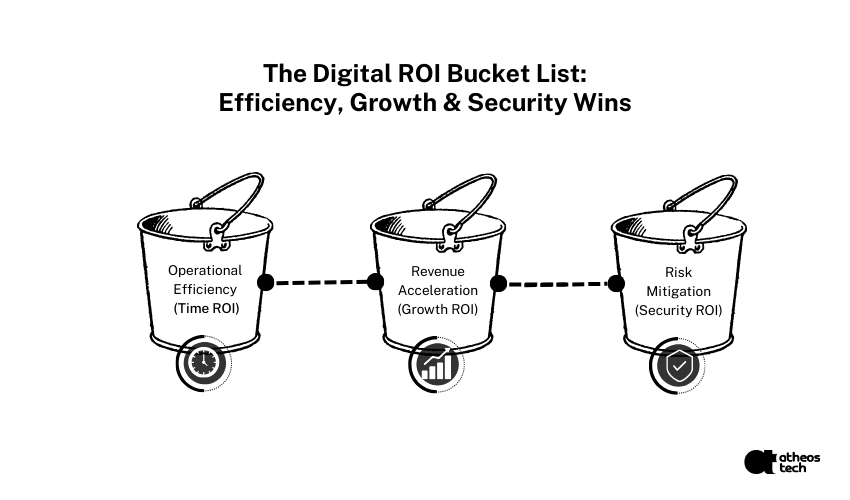
Hire UI UX Designer to Transform Your Brand Across Every Digital Channel

“70% of digital transformation initiatives fail – and the #1 reason isn’t bad tools. It’s bad planning.”
(Source: McKinsey, Deloitte, and every frustrated SMB founder ever.)
That’s not a scare-stat. It’s your warning label.
You’re not falling behind because you’re underfunded – you’re falling behind because your digital investments are misaligned, misused, or just misunderstood. Your tech stack isn’t a strategy. It’s just an expensive to-do list if it’s not tied to a business outcome.
This blog is the financial reality check for those who skipped the structured planning we laid out in From Chaos to Clarity: A Digital Planning Framework for SMBs. Because here’s the blunt truth:
Without a digital roadmap, your budget isn’t an investment engine – it’s a leaky boat – it’s bound to drown.
And leaks cost more than just money. They bleed time, morale, opportunity, and competitive edge.
Let’s plug the leaks and turn that stack into strategy.
Spoiler: It’s not just the tools you buy. It’s how – and why – you buy them.
Studies show that most SMBs use only 40-60% of the features they pay for. The rest is digital waste. Many small business IT solutions promise a high ROI, but without being aligned to your specific processes and people, they just become expensive digital clutter.
Let’s get one thing straight:
Spending more on software doesn’t mean you’re progressing.
It’s not the tools that fail. It’s the lack of a plan. Here are the four biggest budget leaks silently draining your growth potential – and how to plug them.

Marketing ≠ Strategy. And a sexy demo ≠ business fit.
This is a classic:
Buying software because it’s “AI-powered,” “enterprise-grade,” or had a great demo… not because it solves a mapped, validated pain point.
Mini Case-in-Point:
A 10-person marketing agency buys a $30k/year analytics suite with predictive models, sentiment scoring, and dashboards galore.
But here’s the punchline: They don’t even have CRM data cleaned.
Google Analytics + Data Studio would’ve covered 100% of their actual needs.
Consultant Insight:
FOMO, peer pressure, and vendor panic drive more purchases than needed.
A strong small business consultant doesn’t chase trends – they diagnose bottlenecks and align tech to operational strategy.
You see $150/month. You miss the $5000 integration invoice.
License fees are the surface cost.
But the real money leaks are buried in the Total Cost of Ownership (TCO) – the hidden expenses that hit post-purchase.
Breakdown the Iceberg:
Analogy:
Buying software is like buying a yacht.
The sticker price is just the beginning.
Garbage In, Faster Garbage Out.
There’s a dangerous assumption in SMBs:
“If we automate it, it’ll work better.” No. If your process is flawed, you’re just speeding up the dysfunction.
Case Example:
A company rolls out a $40k invoicing system to fix payment delays.
But the real issue?
Sales > Ops handoff was still manual and error-prone.
Result: Invoices go out wrong – just faster and more often.
Consultant PoV:
“The process failed. The software just made it fail faster.”
This is where consulting services for small businesses shine – they fix the process before plugging in the tool.
You bought it. They ignore it. Now what?
You’d be shocked how many tools SMBs pay for that no one actually uses.
Why? Poor onboarding. Complexity. Confusion. Zero ownership.
True Cost of Low Adoption:
Unlike tool resellers, small business consulting firms focus on adoption – not just implementation.
They ensure the right team owns the right tools with the right training.
You can’t justify your investment in small business IT solutions if you can’t measure the return.
Ask yourself:
Why did we buy this tool?
Can you answer with a KPI? Or was it more like: “We needed something better”?
Mini ROI Framework:
Without this level of tracking, you’re flying blind.
A small business consulting company makes ROI visible – tying every tool to a business goal and measurable result.
| Leak Type | Root Cause | The Real Cost |
|---|---|---|
| Shiny Object Syndrome | Buying without mapping | Overspend + underuse |
| Hidden Cost Iceberg | Ignoring TCO | Surprise bills + longer ROI runway |
| Broken Process Automation | Tech before process | Scaled inefficiency |
| Zero Adoption | Poor training/ownership | Dead software + lost morale |
| No ROI Tracking | No baselines | Budget bloat with no direction |
Tomorrow’s Leaders Diversify Today. Be One of Them
So, how do you plug the leaks? You start by measuring the flow.
You can’t manage what you don’t measure. The single biggest reason SMBs get trapped in a cycle of wasteful spending is that they treat technology as an “expense” to be minimized rather than an “investment” to be measured.
Before you renew another subscription or sign a new contract, ask which of these buckets it fills.

This is the easiest and most immediate return you can measure. The goal here is simple: you are buying back your team’s time from repetitive, low-value tasks so they can focus on high-value work.
The formula is dead simple:
(Hours Saved Per Week) x (Average Fully-Loaded Hourly Employee Cost) = Weekly ROI
You implement a tool that saves your operations team a collective 10 hours per week on manual data entry. If your average team member costs you $50/ hr, that’s a $26,000 annual return on that investment. Is the tool costing you less than that? If yes, it’s a win.
This is the most powerful type of return because it directly fuels your growth. This metric ties a technology investment directly to your top-line revenue. It answers the question: “Did this tool help us make more money?”
You don’t need a complex attribution model. Start with direct questions:
If a tool can’t be linked, even loosely, to generating more revenue, you have to seriously question its strategic importance.
This is the hardest bucket to put a number on, but it’s often the most critical for long-term survival. This ROI is about cost avoidance. It’s the insurance policy you buy to protect you from catastrophic failures.
Think of it in terms of preventing expensive problems:
A truly strategic tool will often deliver returns in all three buckets. A tactical tool might only deliver in one. But if you can’t place a tool into any of these buckets, you haven’t found an investment. You’ve found a leak.
| ROI Bucket | What to Measure | Example Tool Impact |
|---|---|---|
| Efficiency | Hours saved x Employee cost | Project management software streamlines task delegation |
| Growth | Leads closed x Deal size | CRM helps increase conversion rates by 20% |
| Insurance | Downtime avoided, risk reduced | Backup system prevents $50k loss during outage |
Small business consulting companies don’t just help you buy tech – they help you define, track, and realize ROI before the invoice hits.
Implementation without ROI is just digital debt.
If three or more of these are true, you’re not investing in tech – you’re funding chaos.
KISS (Keep It Simple, Silly):
You don’t need a finance audit – just five minutes of honesty.
Here’s your self-diagnosis. Count how many you say “yes” to:
Scoring Guide:
If This Sounds Familiar…
You don’t need another tool.
You need a plan.
One that connects your tools to your people, your process, and your business goals – in that order.
That’s what real small business consulting firms do.
Not sell you more apps, but help you make every tool count.
The Future of Business Is Multi-Stream.
Let’s Design Yours Today.
Let’s be blunt:
Tech doesn’t waste money. People do – when they skip planning.
If you’ve seen your digital budget balloon without real results, the issue isn’t stinginess – it’s chaos masquerading as productivity.
This blog exposed the leaks. But the real fix?
Strategic alignment, not budget cuts.
This is exactly why we built the 4-Layer Digital Planning Framework in “From Chaos to Clarity” – to help SMBs stop reacting and start mapping.
When your spend is guided by process clarity, adoption planning, and measurable ROI?
Your budget becomes a growth lever. Not a liability.
Final Thought
The best ROI won’t come from the flashiest tool.
It’ll come from strategy-first execution – where your people, your stack, and your roadmap all point in the same direction.
Stop treating your tech stack like a pile of monthly bills.
Start treating it like what it actually is:
A high-performance engine of integrated small business IT solutions designed for scaling your business.
Let’s Audit Your Digital Spend Together
Are you confident your digital budget is driving growth, or do you suspect it might be leaking? Let’s find out.
If you’re ready to move from guessing to knowing, we invite you to take the next step.
Book a complimentary 30-minute Digital Spend Audit.
Adding {{itemName}} to cart
Added {{itemName}} to cart